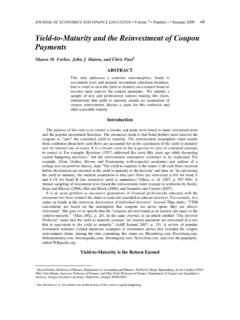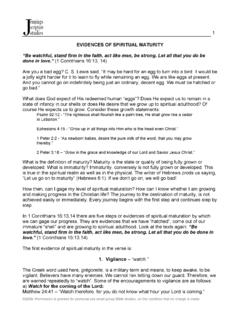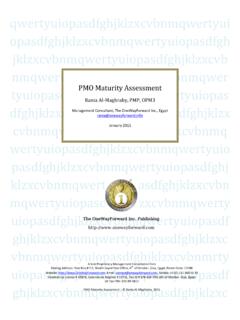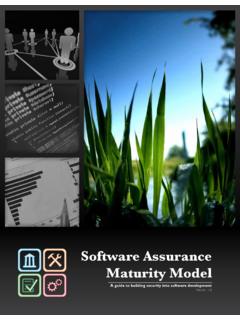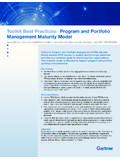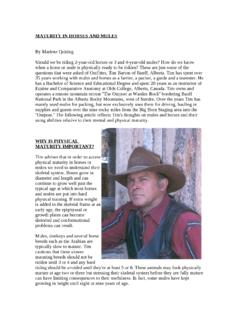Transcription of Conducting Effective Project Management Maturity ...
1 IMSI TECH 2005 Conducting Effective Project Management Maturity assessment Interviews Steve J. Holmes, PMP and Robert T. Walsh Integrated Management Systems, Inc., Ann Arbor, MI Abstract Assessments of a company s Project Management Maturity are dependent upon the ability of the assessors to extract meaningful information from members of the subject company s Project Management community and intelligently evaluate that information to draw meaningful conclusions. Typically, the assessors will be outside consultants, hired for their reputed expertise and experience, with no intimate connection to the subject company or its employees. While this unbiased contributes to the objectivity of the assessors observations, it poses challenges in acquiring and validating information. Interviewing is one of the tools used by assessors to compile the full breadth of information about the subject company that is needed to complete the Maturity assessment .
2 Face-to-face interviewing may be the most significant tool in the assessor s toolbox, as it provides a bridge across the relationship-gap between the assessor and the subject company employees. To be Effective , interviewing requires more effort to prepare, effort to complete, and effort to evaluate than many of the other tools, but it ultimately provides greater value from the information obtained. This paper discusses the use of face-to-face interviews to gather information needed to assess a company s level of Project Management Maturity . It will also compare and contrast interviewing to other information gathering methods in the assessor s toolbox to demonstrate the advantages offered by interviewing. The authors will draw from their personal experiences to describe Effective methods for breaking the ice in an interview, and for arriving at a focused conversation that can be customized to the background and interests of the interview participant and still yield meaningful information about the subject company.
3 While the primary focus of this paper is on interviews within the context of a Maturity assessment , much of the discussion has applicability to other activities of Project managers. Gathering information for a normal Project update often requires the Project manager to interview Project team members. The advantages and difficulties of face-to-face interviews, and the recommended interview process described herein can be beneficial in that circumstance as well. Introduction to Project Management Maturity General overview In general terms, Management is the process or personnel responsible to plan, obtain, control, guide, direct, train, and oversee the use of resources needed to achieve the goals of a business in a timely manner. Project Management is a specific subset of the general process or organization and follows the same basic definition, with the added proviso that Project Management is bounded in time and scale. More and more businesses are recognizing the benefits offered by Project Management to their organizations.
4 By segmenting their work into defined and bounded projects, corporate Management can bring a focused and dedicated effort to bear on each task. Success, however, requires that the business not only be broken into projects, but also that each Project is well managed. Simply put, the benefits derived from Project Management increase in proportion to how well Project Management processes are used. A well-executed Project will be completed on time, within its approved budget. A well-executed Project will deliver higher product quality by managing the time to design and test the new product. It will provide great satisfaction to its team, and it will meet (or exceed) the customers expectations. In today's business environment, it is critical that each Project is run in the most efficient manner possible. For a Project -oriented business, it is equally imperative that all projects are managed consistently, so that the benefits of well-executed projects extend corporate wide.
5 Conducting Effective Project Management Maturity assessment Interviews Holmes and R. T. Walsh IMSI TECH 2005 January 17, 2005 Page 2 Managing projects consistently requires that an organization develop and maintain some standards and methodologies that are shared across the enterprise and used effectively by all of the Project teams it employs. Increasing the level of sharing and expanding the commonality of Project Management methodologies across all projects is the embodiment of organizational Maturity . There are numerous Maturity models that have been promulgated throughout the world. Many of these models follow the pattern of the Software Engineering Institute s Capability Maturity Model (CMM), first described in 1987. A common factor of these models is a five-step progression of the level of Maturity in organizational processes. Level 1 is the beginning of the progression, generally characterized by a shared recognition of the organizational process being examined.
6 Moving to Level 2 requires an organization-wide adoption of a common vocabulary and the identification of standardized processes. Each Maturity model describes the organizational characteristics necessary to achieve each different level, all ending at Level 5, wherein the organization culture has fully embraced the process, optimized the process in its current state, and seeks to continually improve the process going forward. Practitioners in the field have developed many Maturity models for Project Management . Integrated Management Systems Incorporated (IMSI) has examined a number of these candidate models, and from this research, and the collective experiences of its employees, IMSI has developed its own methodology for assessing the status of Project Management within a client organization. The IMSI Project Management assessment Model IMSI's Project Management assessment model is a typical, five-step Maturity model (see Figure 1), as this form provides a solid foundation from which to build.
7 IMSI does not, however, focus on reaching a Maturity rating for a company or organization. Instead, IMSI uses this model to guide an evaluation of the levels of sophistication contained in various processes used by that organization to manage its projects. The IMSI assessment model is employed to identify incremental steps to improve how a company manages its projects and to increase the likelihood of achieving Project success. The IMSI assessment model looks at each of the Project Management knowledge areas and the enablers, critical elements and processes associated with them. If, as asserted earlier, the benefits derived from Project Management increase in proportion to how well Project Management processes are used, the intent of the IMSI Project Management assessment model is to help organizations better use the Project Management processes, elements, and enablers. Appendix A contains a tabular summary of IMSI's assessment model, segmented by the key knowledge areas.
8 Each knowledge area is broken into significant sub-elements, and for each sub-element, the model describes touch-points on the continuum of improvement. While the model is characterized as a stair-step process when shown graphically, it should more accurately be portrayed as a series of slopes, up which an organization can travel. Project Management is, itself, a complex process, which requires more than a cursory sharing of Lessons Learned or simple declaration of Best Practices, to identify and institutionalize improvements that will benefit all future projects. Maturity assessments of organizational development have been created and applied to a number of different companies and industries to help manage the Figure 1 IMSI s Project Management assessment Model Need Awareness(1)Organized &Documented(2)PortfolioManagement(4)Cont inuingImprovement(5)ImplementingPMMethod ologiesFocusing onProcessImprovementPM ProcessesMeasured &ControlledPM PracticesUsed &AdaptedBought In /Integrated(3) Conducting Effective Project Management Maturity assessment Interviews Holmes and R.
9 T. Walsh IMSI TECH 2005 January 17, 2005 Page 3 challenges of technological, economic, and competitive change and to point the way to institutional improvements. The result of a Project Management assessment will lead Management towards setting goals and prioritizing the areas that require improvement. It will further provide a baseline by which the organization can track the progress made towards its goals. It will ultimately help the organization build a culture of Project Management excellence. Project Management Maturity assessment Toolbox Interviewing is one of the tools used by assessors to compile the full breadth of information about the subject company that is needed to complete the Maturity assessment . Face-to-face interviewing may be the most significant tool in the assessor s toolbox, as it provides a bridge across the relationship-gap between the assessor and the subject company employees. As indicated in Figure 2 below, face-to-face interviews are only one of the tools in the assessor s toolbox.
10 All of the assessment tools provide some insight into the host company, but each has limitations. It is recommended that many of the tools be utilized in conjunction with one another to provide a complete and thorough Maturity assessment . Advantages of face-to-face interviews A people-to-people tool within a people-oriented business Project Management is ultimately a people-oriented business that requires personal interactions by and between all of the Project team members. Face-to-face interviewing extends this principle to Maturity assessments. Not only does the interview provide an interpersonal connection between the interviewer and the interview participant, it allows the interviewer to begin to assess the people skills of the personnel assigned to manage projects at the subject company. Interview participants who display grace and candor during the interview are more likely to carry those traits into their Project teams, and are more likely to be open to the recommendations for change or improvement that will flow from the assessment study.
